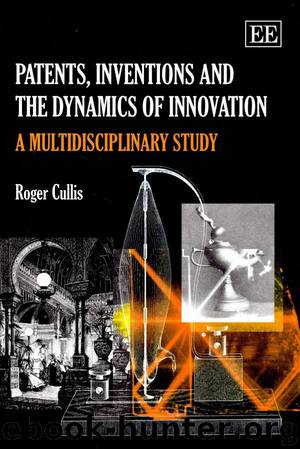Patents, Inventions and the Dynamics of Innovation by Roger Cullis

Author:Roger Cullis [Cullis, Roger]
Language: eng
Format: epub
Publisher: Edward Elgar
Published: 0101-01-01T00:00:00+00:00
Admiralty Office, 5th August, 1816.
Mr. Barrow presents his compliments to Mr. Ronalds, and acquaints him with reference to his note of the 3rd instant, that telegraphs of any kind are now wholly unnecessary; and that no other than the one now in use will be adopted.
Stanley Mullard was born in 1883 just as Edison and Swan were beginning to make a success of the carbon filament lamp. At the age of fourteen he started work in a small electric-lamp company managed by his father. In 1910, after a brief spell at a large well-run lamp factory in France, he joined Ediswan, where he made his mark by improving quality control on the production line. In 1913 he was put in charge of the clamp laboratory, where he encountered the soft triode valves which were being made for Marconi (Geddes 1991, p48). Whilst working in the laboratory, he developed the Pointolite, a high-intensity, sealed tungsten-arc lamp. Through this, he established an all-important contact with the Royal Naval Signal School at Portsmouth.
In 1916, Mullard was invited to accept a commission in the Royal Naval Volunteer Reserve force and set up a large laboratory and valve-testing station in London to monitor the production of 'R' valves for the armed services. During his service career he forged strong contacts with officers from the Signal School, and was instrumental in realising a proposal for the use of fused silica instead of glass for the envelopes of high-power transmitter valves. This was attractive because it offered the prospect of greater reliability as it had a higher melting point and lower expansivity than glass, but it was extremely difficult to work. Following demobilisation, Mullard continued to work on the idea with ex-colleagues still at the Signal School. By mid-1920, he had established the silica valve as of great potential importance to the Royal Navy and was asked if he could produce the valves in quantity. The Mullard Radio Valve Co. Ltd was registered on 17 September 1920, with the Radio Communication Company, a competitor of Marconi in marine radio, as a major shareholder.
Sustained by the silica valve, Mullard diversified into the manufacture of the industry-standard 'R' valve by producing a variant of the basic design which was better engineered but cheaper. His improved quality control meant that he could profitably sell at 15s (75p), half what his competitors were charging. They were forced to come down to his price, suffering a substantial reduction in profitability.
In 1923 Marconi decided to enforce its position and picked on Mullard's start-up company as a potentially soft target. They commenced proceedings for infringement of two key patents, allegedly relating to the 'R' valve. Mullard defended the action vigorously, calling on his links with the Admiralty for support. As a company founded to supply the Royal Navy with silica valves vital to its communications, Mullard had received an assurance of Admiralty support in its defence (Sturmey 1958, p43). Unusually for proceedings involving an ostensibly private organisation, his defence was prepared by the Treasury Solicitor.
Download
This site does not store any files on its server. We only index and link to content provided by other sites. Please contact the content providers to delete copyright contents if any and email us, we'll remove relevant links or contents immediately.
| Automotive | Engineering |
| Transportation |
Whiskies Galore by Ian Buxton(40332)
Introduction to Aircraft Design (Cambridge Aerospace Series) by John P. Fielding(32338)
Small Unmanned Fixed-wing Aircraft Design by Andrew J. Keane Andras Sobester James P. Scanlan & András Sóbester & James P. Scanlan(32141)
Craft Beer for the Homebrewer by Michael Agnew(17446)
Turbulence by E. J. Noyes(7039)
The Complete Stick Figure Physics Tutorials by Allen Sarah(6638)
Kaplan MCAT General Chemistry Review by Kaplan(6054)
The Thirst by Nesbo Jo(5785)
Bad Blood by John Carreyrou(5769)
Learning SQL by Alan Beaulieu(5412)
Weapons of Math Destruction by Cathy O'Neil(5037)
Man-made Catastrophes and Risk Information Concealment by Dmitry Chernov & Didier Sornette(4736)
iGen by Jean M. Twenge(4702)
Digital Minimalism by Cal Newport;(4542)
Life 3.0: Being Human in the Age of Artificial Intelligence by Tegmark Max(4507)
Audition by Ryu Murakami(4099)
1,001 ASVAB Practice Questions For Dummies by Powers Rod(4038)
Electronic Devices & Circuits by Jacob Millman & Christos C. Halkias(4027)
Pale Blue Dot by Carl Sagan(4001)
